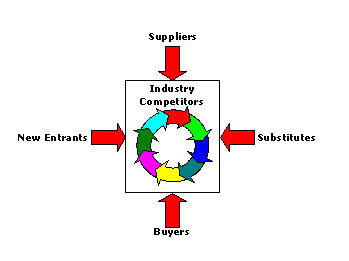Digital Printing
Published
17 years agoon

I'm happy that Screen Printing magazine invited me to address this readership and present some of the analysis that I prepare in my role at InfoTrends. In future installments of this column, I will be writing mostly about the potential and reality of wide-format digital printing technologies, as that is what I spend my time tracking. But for my first article, I want to write about how I would look at the screen-printing market.
One of the very helpful tools I use in my work is a classic model for the strategic consideration of profitability in any industry that was originally developed by one of my heroes, Michael Porter. In a nutshell, Porter's model allows us to consider the influences of five different market forces. In the screen-printing industry, these forces might include the influence of suppliers, new market entrants, substitute products, buyers, and internal market competition (Figure 1).
Let's just examine these issues separately, because as a screen printer, you have to analyze your market and strategy based on an honest assessment of what is happening. Consider first the influence of suppliers to the screen-printing industry. Are ink prices going up? How do you react to that? Do you sacrifice profit margin, or can you pass that price increase on to your customers? Or are there other ink suppliers from which you can get your ink? How married are you to your suppliers? Do their products enable you to differentiate yours? If your suppliers are adding to your strategic advantage, then kudos to them and great for you, but if the opposite is true, perhaps it is time for a reevaluation.
What about new market entries? Are new companies popping up in the screen-printing industry in your local market, or is the level of expertise and capital equipment required enough to create a barrier to market entry? Well, on the digital side the cost of equipment keeps coming down, lowering the barrier to overall market entry. However, many new digital market entries would be limited by the ability to sell against screen-printing establishments with expertise and long histories in the making and selling of printed materials.
Also, are there alternative methods for delivering the same finished product that you deliver? Are there other ways to deliver the message or materials you currently produce? Consider those companies that produce outdoor advertising materials. Are they threatened by the rapidly growing number of outdoor digital displays? Maybe not this year, or even in the next couple years, but it is definitely a market development they have to monitor.
What about your customers? Are you seeing a trend to lower run lengths, and how are you reacting? Do customers expect to pay more, less, or the same for your services as they did last year? I would argue that in many cases, customers expect to pay less for the same or better service year after year.
Finally, what is the nature of competition within the screen-printing industry? Is it a cut-throat business, or are there cooperative efforts and a sense of common struggle that keeps profit margins at an acceptable level? What is the influence of developing nations on the US screen market? Lately, we have seen a lot more advertising from companies in developing countries suggesting their ability to fulfill large screen-print orders at a significant discount. I would not suggest that these are having a major impact on the market in terms of volume production, but it certainly adds to the amount of information buyers have when pricing projects.
The beauty of Porter's model is two-fold in that it is portable for any industry and that it is dynamic, meaning the forces to consider are highly changeable. The downside of Porter's model is that it does not consider the internal influences and capabilities of a company, or its ability to take advantage of certain market changes. This brings us to why I, an analyst of the wide-format digital printing market, have been asked to write for Screen Printing magazine. Since I believe that screen printing is a relatively mature market, I thought I could use this space to consider four ways to grow in a mature market using wide-format digital printing.
Grow the market
The first way to grow is to grow the overall market. While this may seem like a boil-the-ocean request, it really means that you may be thinking "this is how many dollars are out there for my type of printing services." But what about other types of printing? Here is where wide-format digital printing can really be a strategic advantage, because with some of the advanced capabilities of the latest generation of equipment and supplies, the range of applications that can be produced is incredible. When you think of some of the applications, like vehicle wraps, building wraps, floor graphics, and window graphics—all of which can now easily be produced—it does expand the over-all market.
This is also where, once you have acquired a wide-format digital printer, you can influence the overall market with your advertising and marketing budget. This may mean something as simple as developing a targeted marketing campaign for some local businesses. Think about what those companies may need, develop a portfolio of the types of capabilities you have, and send it to businesses in your area. Remember, though, that end users care a lot less about how fast or wide your equipment is and a lot more about how the services you provide can help their business.
Sell more
Okay, say that you think the overall market is growing about as fast as it could, but you still are not reaching your growth goals. Another way to grow faster is to simply sell more. That sounds so silly as I write it, because obviously everybody wants this, but how do you do it?
Start by answering these questions: Are there opportunities for you to expand your reach (geographic expansion) your portfolio (products) or your services? Do you have an outsourcing strategy? By this I mean are you cooperating with any other print companies to help them handle peak volumes in return for them helping you with yours? The simple term "sell more" means taking market share from somebody else or expanding your portfolio of products and services to grow your share of pocket from existing customers. There are many examples of print-service providers investing in a wide-format printer to use as a proofing device, then using it to make and sell posters as a complement to bigger print jobs, then investing in a bigger wide-format printer once their volumes justify the investment. Sell more of the things that make you the most money.
Are there activities or customers you support that you know are low-margin activities but you still do them, and still support them? That is fine for the slow periods, but it is often difficult to find the time to conduct strategic activities in the middle of getting the job done. If you can find the time and resources to get all the work done profitably and still do the market development work you need to do to find more profitable lines of business, then great. If you are skipping some of the market-development activities that would drive high-margin business in order to complete jobs that are low in margin, then there is a problem.
Isn't it always better to make 30% margin on a $10,000 print job than it is to make 2% on a $100,000 print job? Only you know because only you know how important that $100,000 customer is to your overall business. But if you have some of the type of customers who give you $100,000 projects that you don't feel you profit from appropriately, does it make sense to break your back doing these projects or to focus your efforts on selling projects that are much more rewarding? These are the kinds of decisions you have to make, especially when it comes to wide-format digital, which is often very project-oriented.
Expand into adjacent businesses
You're a screen printer. You produce printed materials. You are part of a professional graphics supply chain. That chain includes your experience and expertise in a variety of fields, like color management, conversion, and logistics. Wide-format digital printing is a logical extension of that business because it also often requires an experienced professional to deliver the finished product. Not too long ago, I spoke to a screen printer who told me he was producing thousands and thousands of posters and signage for a major gas station and convenience-store chain. The print shop was investing in wide-format digital printers though, because the chain wanted to put variable data on some of those materials, which this shop could not cost-effectively fulfill using their screen equipment. The shop found that once the digital equipment was in place, its sales force could present the variable-data capability to a number of other customers.
A simple solution?
Perhaps it seems that I am indicating that wide-format digital printing is the answer to all of your problems. I certainly am not trying to say that. What I am saying is that if you are a screen printer who has not already adopted wide-format digital printing, you should consider it as a way to address both the changing external market factors and your own company's objectives for sales and profit growth. Only you, the shop owners and management, can fully appreciate your company's ability to take advantage of your strengths and meet the challenges of today's market.

Subscribe

Magazine
Get the most important news
and business ideas from Screenprinting Magazine.
Most Popular
-

 Art, Ad, or Alchemy2 months ago
Art, Ad, or Alchemy2 months agoF&I Printing Is Everywhere!
-

 Case Studies1 month ago
Case Studies1 month agoHigh-Density Inks Help Specialty Printing Take Center Stage
-

 Andy MacDougall2 months ago
Andy MacDougall2 months agoFunctional and Industrial Printing is EVERYWHERE!
-

 Columns2 weeks ago
Columns2 weeks ago8 Marketing Mistakes Not to Make When Promoting Your Screen Printing Services Online
-

 Editor's Note2 weeks ago
Editor's Note2 weeks agoLivin’ the High Life
-

 Marshall Atkinson2 weeks ago
Marshall Atkinson2 weeks agoHow to Create a Winning Culture in Your Screen-Printing Business
-

 Thomas Trimingham2 months ago
Thomas Trimingham2 months ago“Magic” Marketing for Screen Printing Shops
-

 News & Trends1 month ago
News & Trends1 month agoWhat Are ZALPHAS and How Can You Serve Them in Your Print Business?






